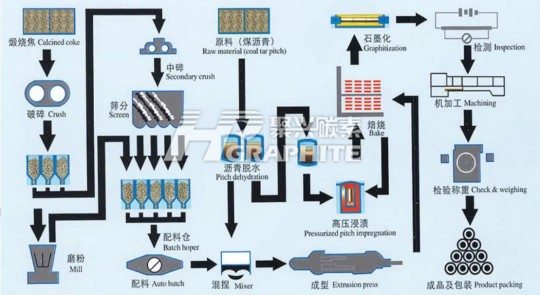Carbon and graphite anode materials (graphitization)

Carbon and graphite anode materials (graphitization)
Human beings have never stopped exploring and using carbon. With the improvement of living standards, the demand for energy is increasing rapidly. Countries pay more and more attention to energy, especially new energy and sustainable energy. Juxing graphite electrode under international graphitization standard for reference.The solar energy industry has a strong demand for special graphite materials; The research, development and production of nuclear graphite materials are becoming more and more urgent; The rise of electric vehicles has also greatly driven the development of carbon materials and high-performance additives for power batteries such as lithium-ion batteries; Traditional carbon materials such as high-performance electrode, brush, high-speed railway conductive slider and carbon block continue to be developed and produced with the development of high-performance products.
There is a great demand for large and super large specifications of various types of graphite in China, including anisotropic and isotropic graphite. Isotropic graphite and high-purity graphite are essential supporting products in solar power generation, nuclear power and electromechanical equipment. Graphene, nuclear reactor, nuclear industry, aerospace, chemical industry and so on are inseparable from graphite and high-purity graphite.

The graphitization of carbon needs to give energy to the high-temperature treatment of carbon, so that the usual disordered structure of carbon can be transformed into the ordered interlayer structure of graphite with van der Waals force.
The degree of graphitization is mainly determined by the purity of carbon and the heating temperature of graphite chemical process, which is the main process for deepening the development and cutting-edge utilization of carbon materials. The melting point of graphite is 3850 ± 50 ℃, and the boiling point is 4250 ℃. Carbon begins to transform into graphite at 1700 ℃. Graphite electrodes for smelting and steelmaking, usually up to 2500 ℃. The temperature of high-purity graphite used in the cutting-edge, such as the cathode material of lithium battery, should reach about 3000 ℃. This heating process is the graphitization process of the carbon industry.
Carbon production processes include calcination, medium crushing, screening, kneading, molding, baking, impregnation, graphitization, processing and other processes. Graphitization process is the key process of carbon—graphite processing. Heating carbon materials to reach graphitization temperature, usually between 2500 ℃ and 3000 ℃. The heating process of heating carbon to graphitization state is generated by electric energy. There are two processes, external heating large DC method and internal heating internal series method.
Graphitization is a key technological step in the industrial production process of large isotropic graphite, small sized brushes, conductive sliders, and even a series of carbon-graphite products such as anode materials for lithium ion batteries.
Graphitization process can be divided into external heating method and internal heating method according to heating mode, and can be divided into intermittent type and continuous type according to operation mode. Since e.g. Acheson invented the graphitization furnace (called Acheson furnace) in 1895, the production of artificial graphite has a history of more than 100 years. With the development of industry, the structure of graphitization furnace has also developed greatly. Acheson furnace has DC furnace and AC furnace. In addition to Acheson furnace, there are also internal series graphitization furnace, continuous graphitization furnace, etc.
After graphitization process, the ash content of carbon products can be reduced by about 70%, and the specific resistance is much lower than that before baking, which is more conductive. The true specific gravity has increased by about 5%. In short, the oxidation resistance, thermal conductivity and chemical stability of carbon products have been improved after graphite chemical process, reading more graphitization technical information.
No related results found








0 Replies